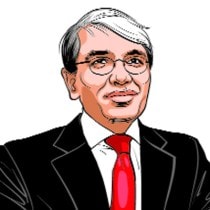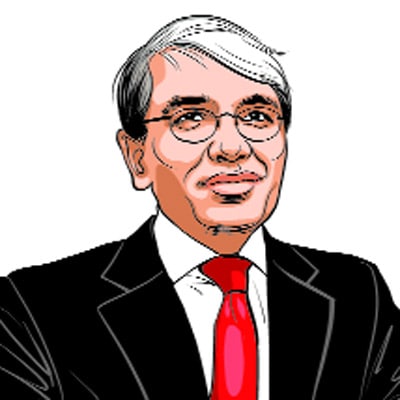The virtues of formality
A massive enterprise formalisation is taking place, and one year of GST has given the process a boost.

GST was launched on the midnight of June 30, 2017, in the Parliament (Express photo by Prem Nath Pandey)
Without employers, there are no employees. But without formal employers, there are few well-paid employees. India’s odds for sustainable poverty reduction have greatly improved with 47 lakh new formal enterprises from one year of GST — a clear disruption to the 64 lakh enterprises previously registered for indirect taxes in 70 years — because formal jobs change lives in ways that no subsidy can. While all enterprises start small and few formal enterprises become large employers, not all enterprises are born equal.
The difference between an enterprise that is a baby (productive enough to grow and pay decent wages) and a dwarf (one that stays small and involves exploiting yourself or others) is often the access to capital, talent, vendors, skills, and technology that comes with formalisation. While there are no guarantees in policy — the odds of winning a lottery are low but the odds are zero without buying a lottery ticket — this massive enterprise formalisation improves the odds of producing more babies (an average Indian enterprise has four employees while the average Provident Fund paying enterprise has 50 employees).
The baffling reaction of India’s poverty industry to last week’s data from the Central Statistics Office — 41.26 lakh new jobs created in the eight months preceding April ‘18 and 6.85 lakh jobs created in April — continues a pattern which sounds like they believe a formal job is not a job. Nobel Laureate Paul Krugman says productivity is not everything but in the long run it is almost everything; India’s problem is not unemployment but underemployment and productivity (our official unemployment rate of 5 per cent is not a fudge). It’s irrelevant whether formalisation is happening because of GST, enforcement, amnesty, thresholds, morality, demonetisation, employee preference, etc. because, as Deng Xiaoping said, it doesn’t matter if a cat is black or white if it catches mice. All data is incomplete but some data is useful; the antibiotic reaction of the poverty industry to every release of new labour market data feels like an inability to see the world anew, an unwillingness to reject old constraints, and a powerlessness to insist India can be better. As an American politician said; you can have your own opinion, but you can’t have your own facts.
Besides GST, formalisation is accelerating because policy-making has finally made the leap from classical physics (discrete systems) to quantum physics (everything is interconnected). Higher wages need the higher productivity that comes from a long-term strategy of formalisation, financialisation, industrialisation, urbanisation and human capital. Aadhaar-enabled Direct Benefit Transfer has saved Rs 49,650 crore in 2014-16. Incremental coal production has grown to 133 MT in the last four years versus 30 MT in the prior four years. Solar capacity added in the last four years was 8.26 times that added in 68 preceding years. Over 22 per cent of all star hotel rooms created globally in the last three years were in India. Total Foreign Direct Investment in five years till December 17 is 57 per cent higher than the previous five years. Demonetisation, digitisation, and bankruptcy have set the stage for a sustainable expansion of our 57 per cent credit to GDP ratio (China’s 211 per cent is an important ingredient of their 300 million people moving from farm to non-farm jobs). The licence raj in higher education is ending and we have the world’s fastest growing apprenticeship system (off a pathetic base). The biggest gift has been controlling our fiscal deficit and taming inflation. But to reuse a wonderful metaphor of Professor Avinash Dixit of Princeton University, informality is not like cancer but obesity.
We must not think of informality as cancer where every malignant cell must be removed or will come back. Instead, informality should be compared to being overweight or obese. The fight is hard and slow; victories are partial, sometimes you regress. But keeping up the fight by all methods can mitigate obesity. Eventually, diet and exercise will become a way of life and a healthier body will yield tangible benefits; we can now imagine an India where informality is the exception rather than the rule. But the task is far from done; we must further reduce the costs of formalisation by creating competition for EPFO and ESI (their monopoly makes them the world’s most inefficient social security programmes), pass a single labour code to eliminate our regulatory sprawl (you can’t comply with 100 per cent of our labour laws without violating 10 per cent of them), issue an Aadhaar-type number to enterprises (to replace 25 plus numbers issued by various government arms), and continued GST simplification.
All entrepreneurs learn three things the hard way: One, change isn’t the solving of a sum but the painting of a picture; two, disruption often shows up as a gentle sunrise rather than a bulb going on; and three, a 10-year plan is not 10 one-year plans. This makes entrepreneurship the art of staying alive long enough to get lucky; Richard Attenborough’s Gandhi was released 20 years after it was proposed in 1962 and TCS took 36 years to reach an IPO valuation of $8 billion; in the next 14 years it reached $100 billion.
Fixing India will take time, but it was not God’s will that it should take 72 years for 1.2 billion Indian to overtake the GDP of 66 million Britishers. One reason for this delayed prosperity was our sense of humour about the rule of law which made the slavery of the 21st century — informality — the norm for 90 per cent of our labour force. Post GST, India’s informal employment may now be 75 per cent of total employment and 50 per cent of non-farm employment. Gandhiji said poverty is the worst form of violence; we can put our poverty in the museum it belongs to by staying the course with formalisation and reaching 25 per cent informal employment. A nice bonus of that journey will be the third-largest economy in the world.
The writer is with Teamlease Services
For all the latest Opinion News, download Indian Express App
More From Manish Sabharwal
- How knowing English helpsDelhi’s move to introduce spoken English lessons for govt school students taps into a long-felt desire...
- Signals from a bankruptcyThe Bhushan case is a brick in the wall of a new corporate meritocracy where rule of law matters...
- Karl Marx: Evaluating the long shadowWe should judge Karl Marx not by his intentions but by the outcomes...







































No hay comentarios:
Publicar un comentario